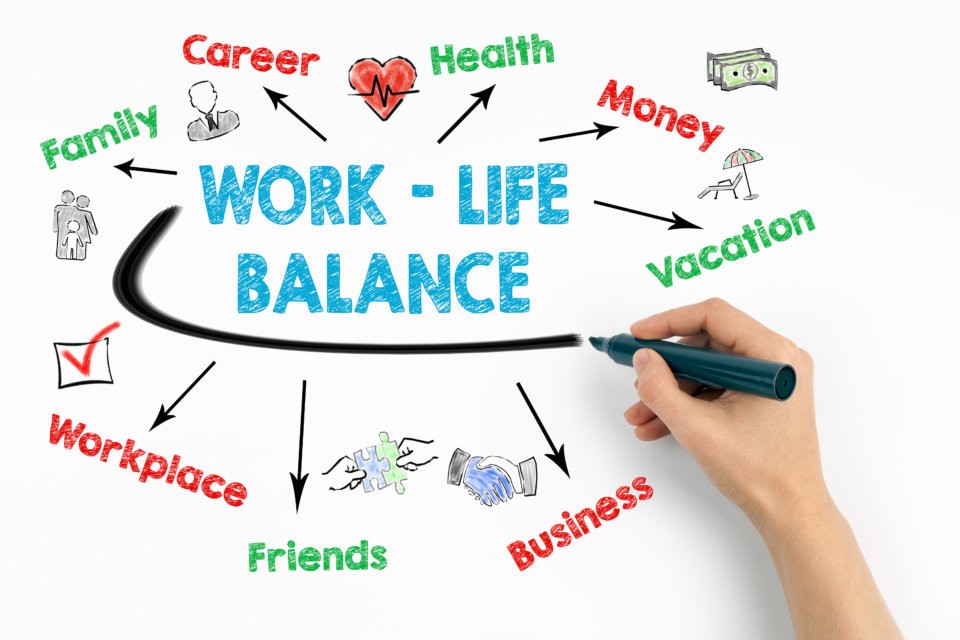Do you ever feel as though your life is being consumed by your work? Or do you seem to be unable to offer your all at work because of so many personal commitments? We all know that work-life balance is essential, but it’s not always simple to strike a balance between your personal and professional lives.
Work plays a major role in our lives. It takes up much of our waking hours during the traditional workweek. That’s why it’s so important to make sure that we are also taking care of the areas of our lives that keep us healthy and happy.
Professional fulfillment can be a part of that, for sure. But well-being also involves all of the things outside of work that makes your life worthwhile, including your family, hobbies, health, and relationships (not to mention sleep, exercise, balanced meals, and relaxation).
Work-life balance generally refers to a balance between your personal and work life. The goal is to strive to keep that balance so that we are managing stress and burnout by fulfilling other areas of our lives that aren’t swallowed up by work.
Remember: That “balance” may shift at times and is never really a 50/50 split. We can accept that there may not ever be a balance, but we can strive to feel more grounded and balanced by making a personalized plan, exploring ways to improve that balance with our manager, taking breaks, and creating set boundaries between our personal vs. professional duties. If we’re in a position to change jobs and our conversations with our manager are unsuccessful, we could also explore other opportunities that offer more flexibility.
For working parents, it often means finding a way to juggle the responsibilities of a career while still finding time for a fulfilling family life. With rising numbers of older workers, work-life balance may focus more on staying active in the workforce while finding ways to manage health issues or disabilities.
Major shifts in how we work have also helped change the definition of work-life balance for many people. For many people, work-life balance meant clocking out at 5 p.m. and not thinking about work until you showed up at the office at 9 a.m. the next day.
Being tethered to an office is a thing of the past for many folks. It makes sense that, for many of us, the option for flexible or remote work is an essential part of work-life balance. This means that work-life balance is much more personal and nuanced these days–but it also makes finding a balance harder than ever before.
Many times people think balance is a 50/50 split but that is not always the case. For each person, the balance may look different and will shift during different seasons of their life. The important part of having balance is that the person does not feel that one area of life is draining and depleting the other.
So how exactly can you tell if you have a healthy work-life balance? It can look a little different for everyone (since we all have different work, family, and relationship situations).
The following are a few signs that you’re striking a good balance between your job and other areas of your life
- You don’t feel like the demands of your work roles and personal obligations are constantly in conflict
- You’re able to meet your deadlines at work without having to work overtime
- You’re getting plenty of sleep at night and eating a healthy, balanced diet
- You don’t spend the end of your weekend consumed by the Sunday Scaries.
- You have plenty of time to relax and enjoy your hobbies
- You feel like you’re spending enough time with family and friends
- You don’t worry about your job when you’re not at work
- You feel like you’re being productive at work and making progress toward your professional goals, but you don’t feel like your whole identity hinges on your job.
- You’re taking your vacation days (and using your sick days when you need them)
- You’re taking advantage of any work-life benefits your employer offers, like gym memberships, flexible scheduling, and childcare vouchers
Remember that work-life balance isn’t something you can just check off your to-do list. It’s only natural that the demands of your job and outside life shift and change over time. That means that what you need to keep the balance will change over time.
Accept that there is no ‘perfect’ work-life balance.
When you hear “work-life balance,” you probably imagine having an extremely productive day at work, and leaving early to spend the other half of the day with friends and family. While this may seem ideal, it is not always possible.
Don’t strive for the perfect schedule; strive for a realistic one. Some days, you might focus more on work, while other days you might have more time and energy to pursue your hobbies or spend time with your loved ones. Balance is achieved over time, not each day.
“It is important to remain fluid and constantly assess where you are [versus] your goals and priorities,” said Heather Monahan, bestselling author and founder of the career mentoring group Boss In Heels. “At times, your children may need you, and other times, you may need to travel for work, but allowing yourself to remain open to redirecting and assessing your needs on any day is key in finding balance.”





Thanks for sharing. I read many of your blog posts, cool, your blog is very good.
Your point of view caught my eye and was very interesting. Thanks. I have a question for you.
Your point of view caught my eye and was very interesting. Thanks. I have a question for you.